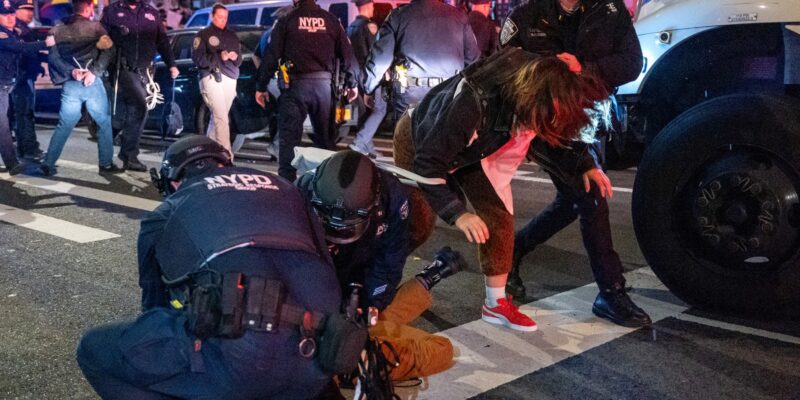
A Columbia protester detained as part of the city’s crackdown against the Gaza Solidarity Encampment says that during her arrest and processing she was forced to take off her hijab—a violation of a New York Police Department policy and another instance of a high-profile problem for the department.
The account of the protester, a Columbia student who wished to remain anonymous out of concern for her security and safety, was corroborated in part by two witnesses. The NYPD did not respond to requests for comment.
The removal of hijabs during arrests has been a years-long problem for New York City law enforcement. On April 5, 2024, the city settled a class-action lawsuit for $17.5 million brought by two women who had been forced to take off their hijabs for a mugshot in 2017. The case, originally filed in 2018, led to changes in policy, when, in 2020, the New York Police Department altered its rules, saying people could wear a “religious head covering,” as long as it did not cover their faces for photos.
According to the NYPD’s Patrol Guide, in some circumstances, an arresting officer can request that a head covering be “temporarily removed and searched.” But this is to be done in “private” and the religious head covering, the guide says, should be returned. Officers only are permitted the “safekeeping” of a religious head covering if there is a danger of violence or self-harm.
The hijabi protester, and others present, say that when the NYPD arrested an autonomous group that had taken over Hamilton Hall at the university these rules were not consistently followed.
The protester said the problems began even before she got to the station. She wears her hijab loosely, and it began to fall off as she was zip-tied and walked to a police van. She asked an officer to fix it—or to let her take off the zip-ties for a moment to adjust it herself. But the police officer refused, and then, following continual requests, relented but according to the protester adjusted and replaced the head covering inadequately, so that it continued to fall off.
“He would tell me it’s because I’m moving around so much or talking,” she recalls. (She had chanted at officers during the arrests.) But despite “exact instructions,” to place the covering upon her head, she says, “He would put it very, very lightly right behind my ear—so immediately it would fall back, like only on half my head.”
During that time, Aidan Parisi, a protester who was arrested inside the building that was occupied, said they saw the hijabi protester’s scarf falling off. “We were standing in line waiting for them to process us and I noticed her hijab had fallen,” Aidan told Mother Jones on the phone, days after the arrest. “There were numerous times I saw her where her hijab kept falling and they were refusing to fix it.”
Parisi also brought the scarf falling off to the officer’s attention. “The police officer said something along the lines of, ‘What do you mean? I keep fixing it. I keep picking it up for you, don’t lie,” Parisi recalls. “And [the hijabi protester] says: ‘Well why was it still down?’”
More importantly, the hijabi protester said, “A man should not be placing his hands on me—period.”
When she got to the jail, the issues continued. Before taking those who were apprehended to their cells, officers pat them down to search for weapons or other contraband. During this process, the protester was asked to remove her hijab to check her hair and head covering. This is consistent with the NYPD’s Patrol Guide’s policy to temporarily ask those arrested who are wearing religious head coverings to remove the item in private for a search.
After this check, the protester asked for her hijab back. The officer, she says, refused to return it. The protester objected but, eventually, she acquiesced. “Even though it made me very uncomfortable,” she said. “I [felt] like I didn’t really have a lot of fight left in me.” She assumed the cell she was entering was all female. (Rules vary, but wearing the hijab is typically observed in front of men.)
“I didn’t know that this was my right,” she said of keeping on her hijab. “[The idea that] this [hijab] is part of my identity [so I] get to keep this one—I didn’t even process that.”
Then she saw another woman enter the same area wearing her hijab. Once more, the protester began to ask the officers to return her hijab: “I was like: give me my hijab back, give me my hijab back.” Allie Wong, a graduate student who served as a “human barricade” in front of Hamilton Hall and was arrested, saw this occur in the jail.
Wong remembers the hijabi protester saying: “This is from my religion and this is my religious and constitutional rights…. And it didn’t matter. They said she had to remove it. She kept protesting and saying it’s her right.” (Despite this occurring in a female section of the jail, male officers were walking in and out, according to both Wong and the protester with whom Mother Jones spoke about the incident.)
After this interaction happened, all three protesters interviewed by Mother Jones recall that the protesters crammed into cells began chanting: “Give her back her hijab.” The protester whose hijab was removed remembers people banging on the walls, too, causing the room to shake. The protester said she did not receive the head covering back until she left the jail several hours later.
She told Mother Jones she could not help but think of a news report she read about women in Gaza who slept with their hijabs on—because they do not know when a bomb will drop and if it happens in their sleep they want to die with dignity.
“I should have put up more of a fight,” she told me. “I wish I knew more of my rights—so I could stand up for myself [but] this has been what has been normalized from the state when protesting.”















